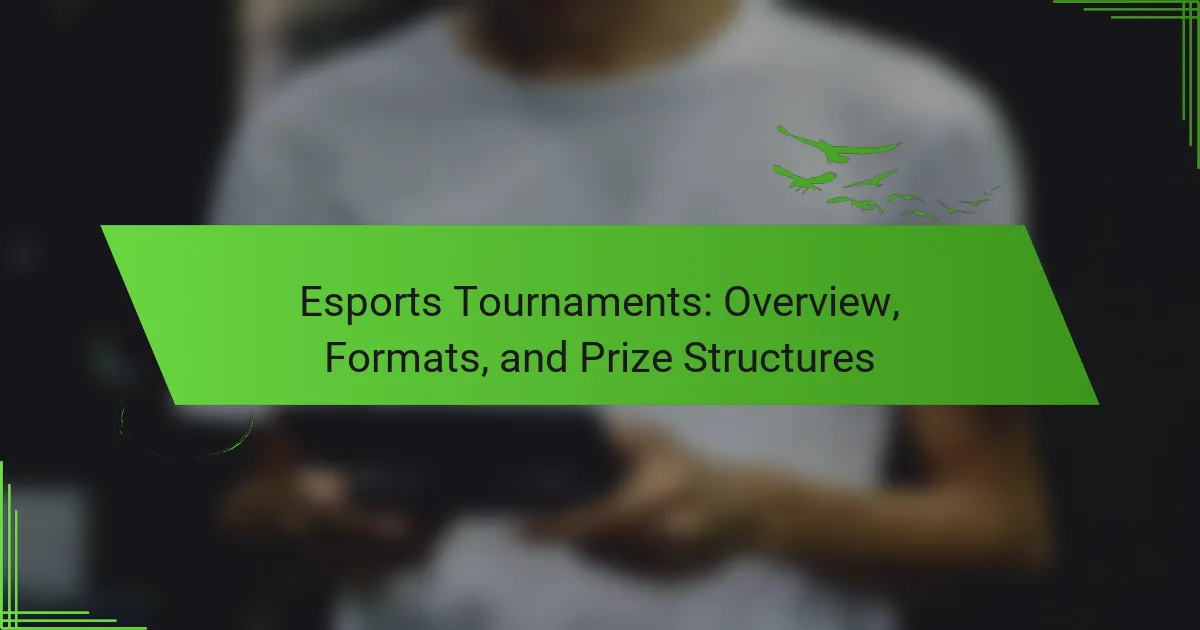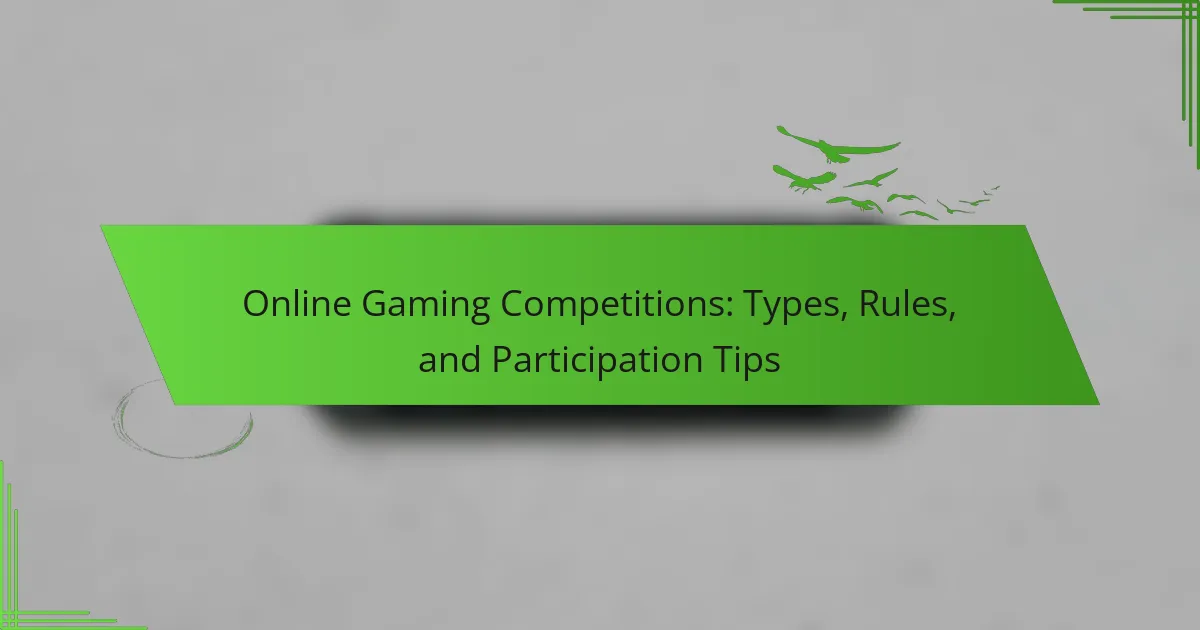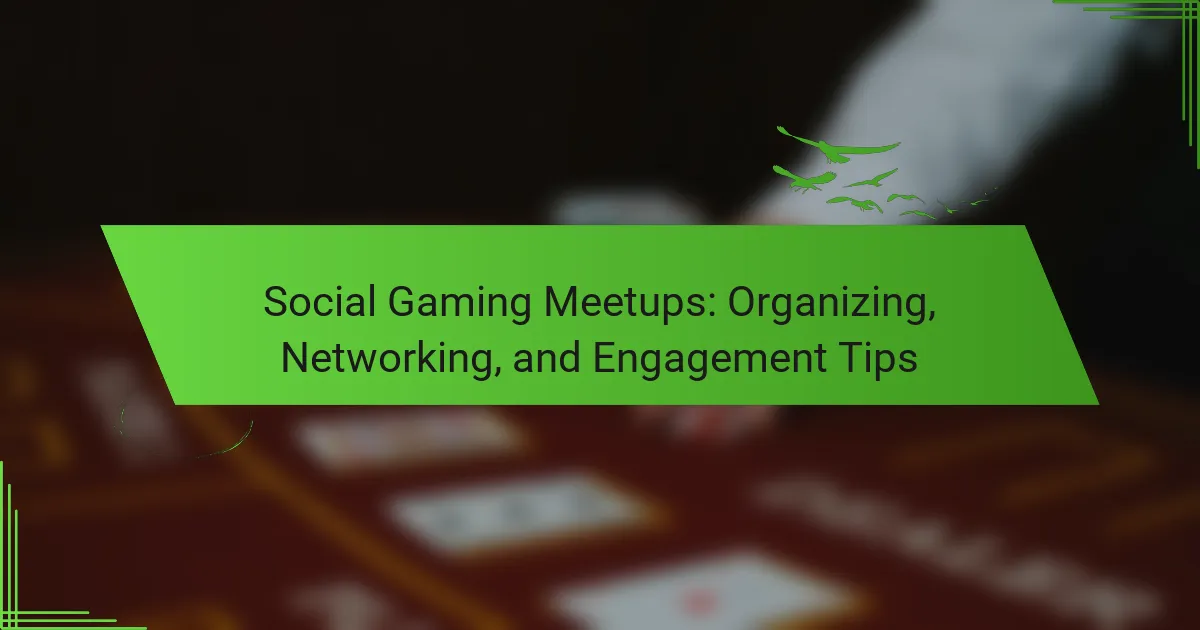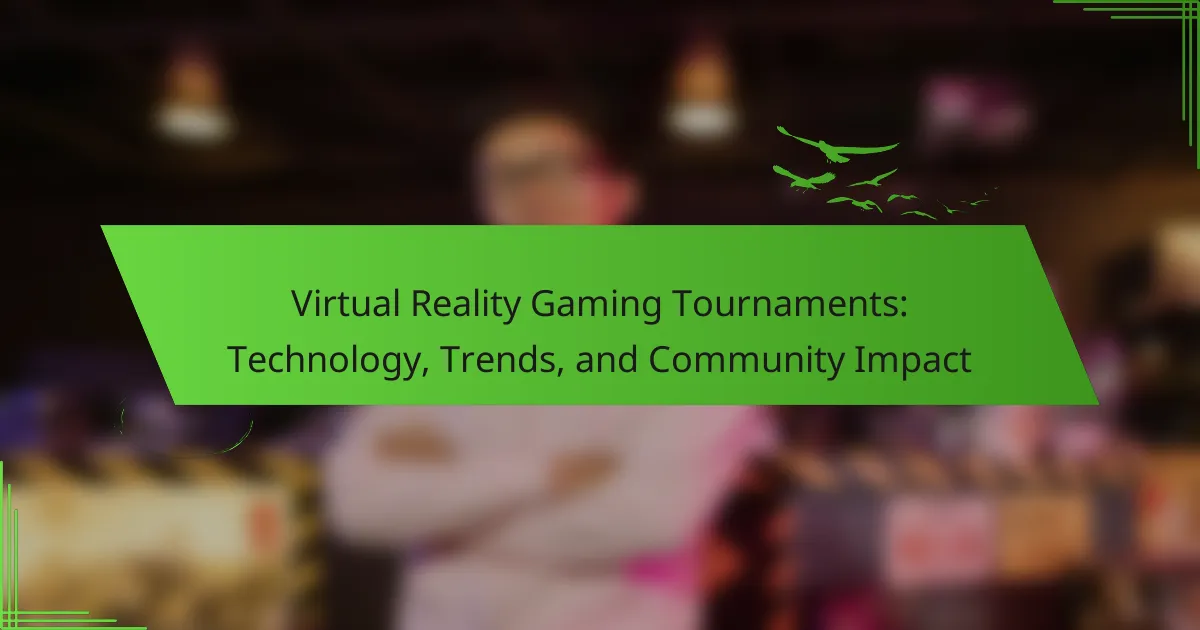Esports tournaments are dynamic events that captivate millions of fans worldwide. This article explores various tournament formats, including single-elimination and round-robin structures, and examines tiered prize structures that reward top performers. It also highlights participant engagement strategies, such as live streaming and fan interactions, that enhance viewer experience. Finally, we address the challenges and trends shaping the future of esports tournaments.
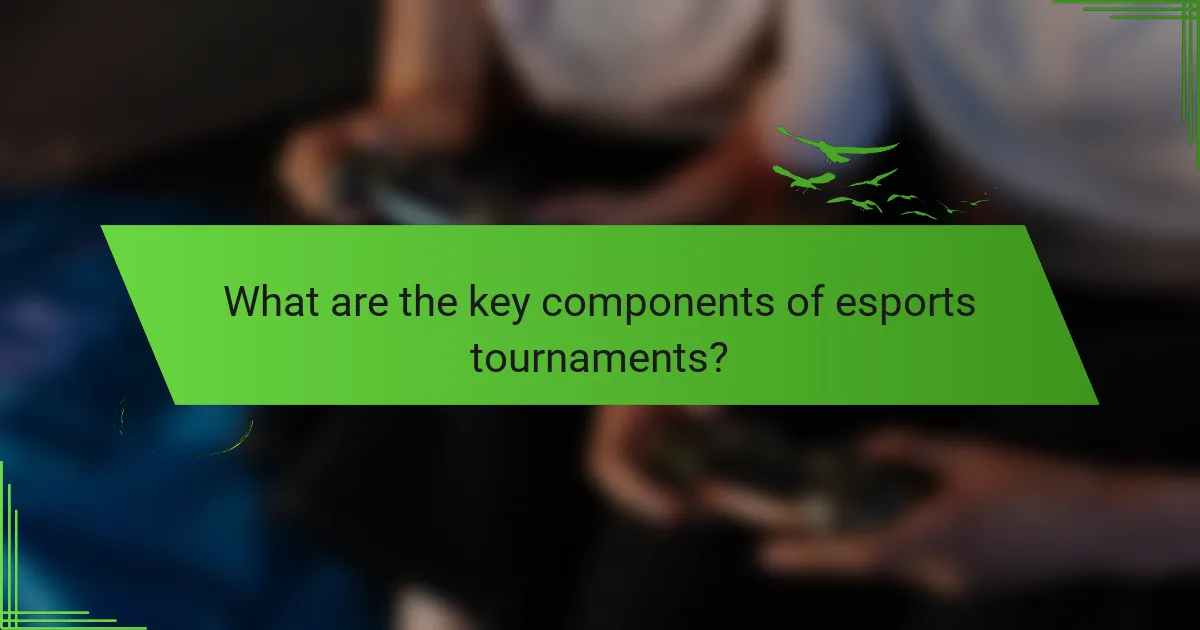
What are the key components of esports tournaments?
Esports tournaments consist of several key components that shape their structure and execution. These components include formats, rules, prize pools, and participant engagement strategies.
Formats can vary widely, including single-elimination, double-elimination, and round-robin structures, each influencing how teams progress. Prize structures are often tiered, offering varying rewards based on placement, with top teams receiving the largest shares.
Rules are essential for maintaining fairness and consistency, covering gameplay mechanics and conduct. Finally, participant engagement strategies enhance viewer experience, utilizing live streaming, commentary, and fan interactions to create a dynamic environment.
How do tournament formats influence player participation?
Tournament formats significantly impact player participation by influencing accessibility, competitiveness, and engagement. Formats such as single elimination, double elimination, and round-robin cater to different player preferences and skill levels. For instance, double elimination allows players a second chance, increasing participation rates. Additionally, formats that include team play can enhance social interaction, attracting more players. The structure of tournaments, including prize distribution, also plays a critical role; higher prize pools often lead to increased interest and participation.
What roles do organizers and sponsors play in tournaments?
Organizers and sponsors play crucial roles in esports tournaments by ensuring smooth operations and providing financial support. Organizers manage logistics, including venue selection, scheduling, and participant coordination. Sponsors offer funding, promotional resources, and brand visibility, enhancing tournament prestige and reach. Their collaboration is essential for successful event execution and audience engagement.
Which platforms are most popular for hosting esports tournaments?
Twitch, YouTube, and Facebook Gaming are the most popular platforms for hosting esports tournaments. Twitch dominates with its large audience and interactive features, while YouTube offers extensive reach and video-on-demand capabilities. Facebook Gaming leverages social connectivity, attracting diverse participants. Each platform provides unique tools for engagement and monetization, catering to different aspects of the esports community.
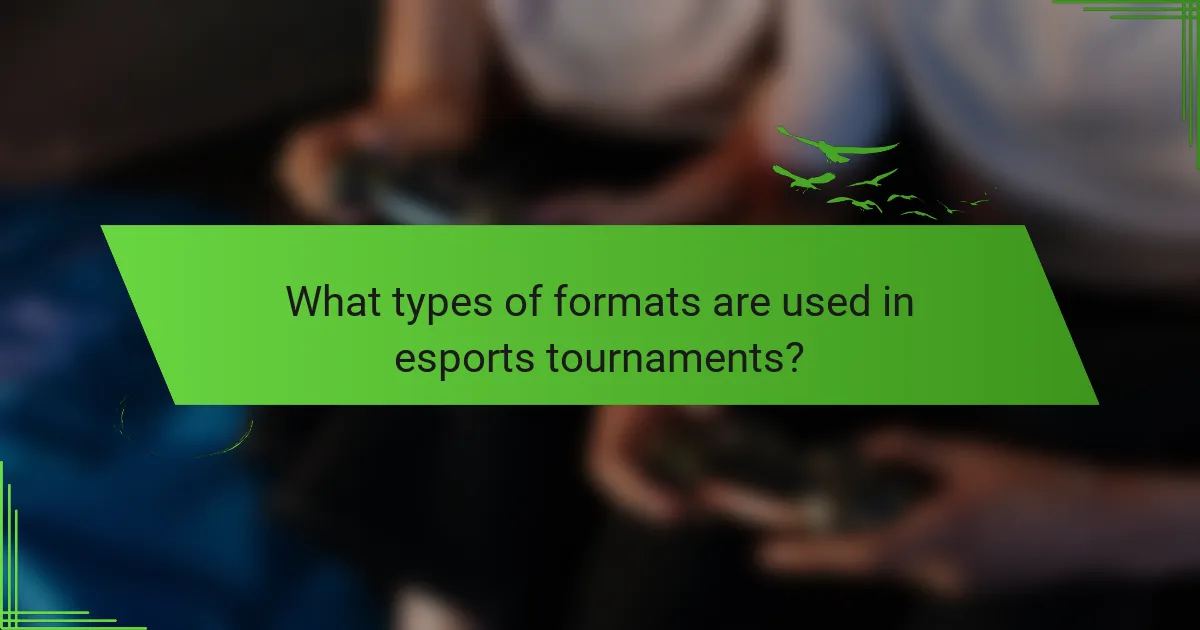
What types of formats are used in esports tournaments?
Esports tournaments utilize various formats, including single elimination, double elimination, round-robin, and Swiss system. Each format has distinct characteristics that influence the progression and outcome of the tournament. For example, single elimination eliminates teams after one loss, while double elimination allows for a second chance. Round-robin involves each participant playing against all others, ensuring comprehensive competition. The Swiss system pairs competitors with similar scores across rounds, optimizing matchups without requiring all participants to play each other. These formats cater to different player counts and competitive structures, enhancing the esports experience.
How do single-elimination brackets function?
Single-elimination brackets function by allowing teams or players to compete in a knockout format. In each round, the losing participant is eliminated, while the winner advances to the next stage. This continues until a final match determines the champion. Each match’s outcome directly impacts the tournament’s progression, emphasizing the importance of each game. Single-elimination formats are popular in esports due to their straightforward structure and quick resolution, making them suitable for various competition sizes.
What are the benefits of double-elimination formats?
Double-elimination formats provide several benefits for esports tournaments. They ensure that teams have a second chance to compete after a loss, which increases engagement and excitement. This format allows for a more comprehensive assessment of team skill, as teams must perform consistently to progress. Additionally, it helps maintain viewer interest by extending the tournament duration and creating more matchups. The structure also encourages strategic play, as teams must consider both winning and avoiding elimination. Overall, double-elimination formats enhance the competitive experience for players and spectators alike.
Which tournaments utilize round-robin structures?
Many esports tournaments utilize round-robin structures, including the League of Legends World Championship, ESL One, and the Overwatch League. This format allows each team to compete against every other team, ensuring a comprehensive assessment of performance. Round-robin formats promote fairness and excitement, as all participants have equal opportunities to showcase their skills.
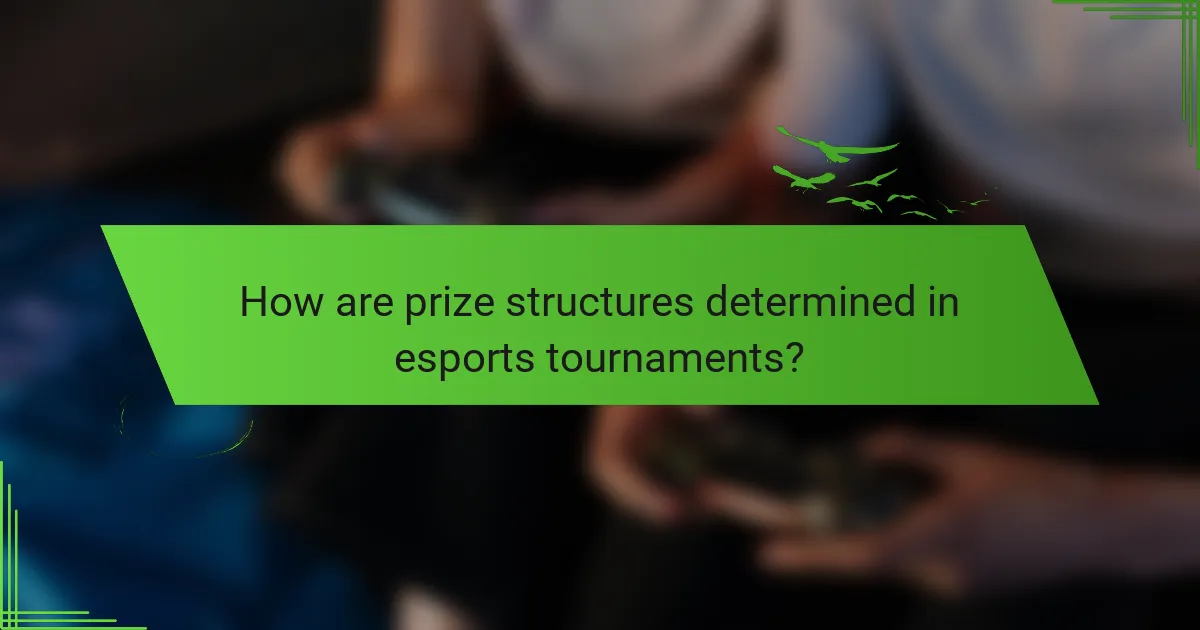
How are prize structures determined in esports tournaments?
Prize structures in esports tournaments are determined by several factors, including sponsorship, player skill levels, and audience engagement. Tournament organizers assess the overall budget and potential revenue from ticket sales and streaming. Prize pools may also be influenced by the popularity of the game and the size of the participant base. Additionally, some tournaments implement tiered prize distributions, rewarding top performers significantly more than lower-ranked participants. This structure encourages competitive play and attracts top talent to the event.
What factors influence prize pool sizes?
Prize pool sizes in esports tournaments are influenced by factors such as sponsorship deals, game popularity, and participant fees. Sponsorships often provide substantial funding, while the popularity of a game can attract larger audiences and more investment. Additionally, entry fees from participants contribute to the overall prize pool.
How do tiered prize distributions affect competition?
Tiered prize distributions enhance competition by motivating players to strive for higher placements. This structure creates a clear incentive hierarchy, where teams aim for top positions to secure larger rewards. As a result, the competitive landscape becomes more intense, encouraging skill development and strategic gameplay. Additionally, tiered prizes can foster greater viewer engagement, as audiences are drawn to closely contested matches with significant stakes. Overall, this distribution model drives both player performance and spectator interest in esports tournaments.
What are the common practices for sponsorship contributions?
Sponsorship contributions in esports tournaments typically involve financial support, product donations, and promotional partnerships. Brands provide funds to enhance prize pools, cover operational costs, or increase marketing reach. They often seek visibility through logos on team jerseys, event banners, and online streams. Additionally, sponsors may offer in-kind contributions, such as gaming equipment or merchandise, which can enhance the tournament experience. This collaboration benefits both parties, as sponsors gain exposure and tournaments secure necessary resources.
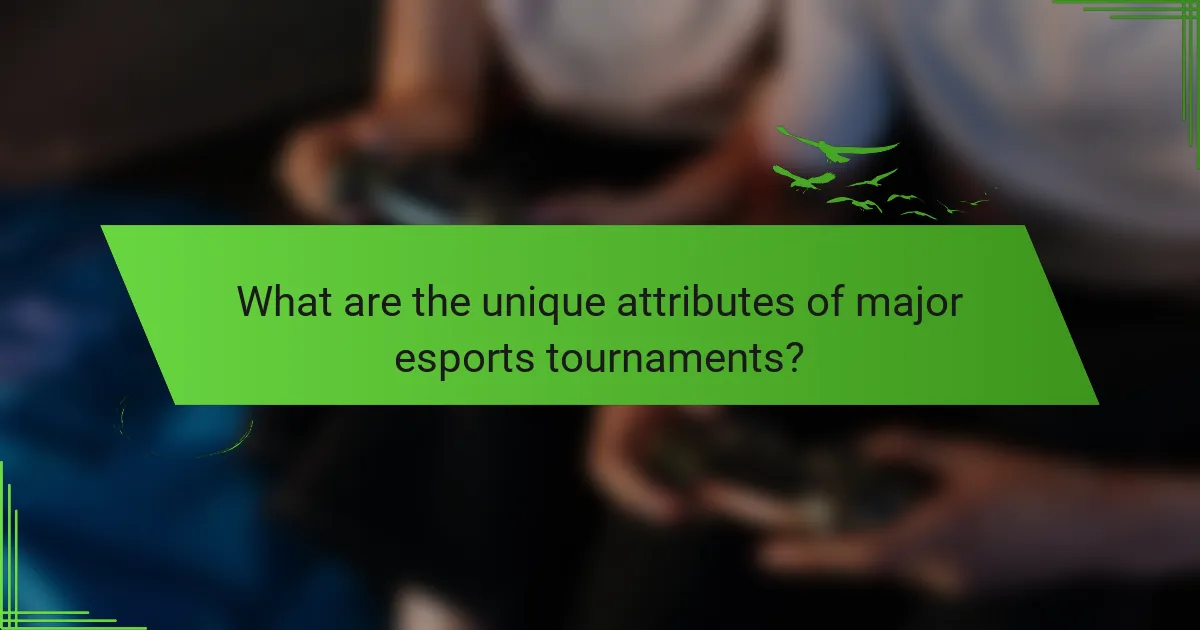
What are the unique attributes of major esports tournaments?
Major esports tournaments have unique attributes that distinguish them from other competitive events. These include diverse game formats, audience engagement strategies, and substantial prize pools.
One unique attribute is the multi-game format, where tournaments feature various titles, attracting a broader audience. For example, events like The International showcase Dota 2 and other games, enhancing viewer experience.
Additionally, prize structures in major tournaments often exceed millions of dollars, incentivizing top-tier talent. The Fortnite World Cup, for instance, had a prize pool of $30 million, setting a record in the esports industry.
Another rare attribute is the integration of live streaming platforms, allowing real-time interaction between players and fans. This engagement fosters a community atmosphere, enhancing the overall tournament experience.
How do international tournaments differ from local competitions?
International tournaments feature larger prize pools and global participation, while local competitions emphasize community engagement and regional talent. International events often utilize diverse formats and attract sponsorships, enhancing their prestige. In contrast, local competitions focus on accessibility and grassroots development, fostering local esports ecosystems. These differences shape the competitive landscape, influencing player experience and audience engagement.
What exclusive features do premier events like The International offer?
Premier events like The International offer exclusive features such as massive prize pools, unique formats, and high-profile sponsorships. These tournaments often showcase the best teams globally, creating a competitive atmosphere that attracts millions of viewers. The International, for instance, has set records with prize pools exceeding $40 million, highlighting its financial allure. Additionally, special in-game items and cosmetics are often released, enhancing fan engagement and providing unique experiences.
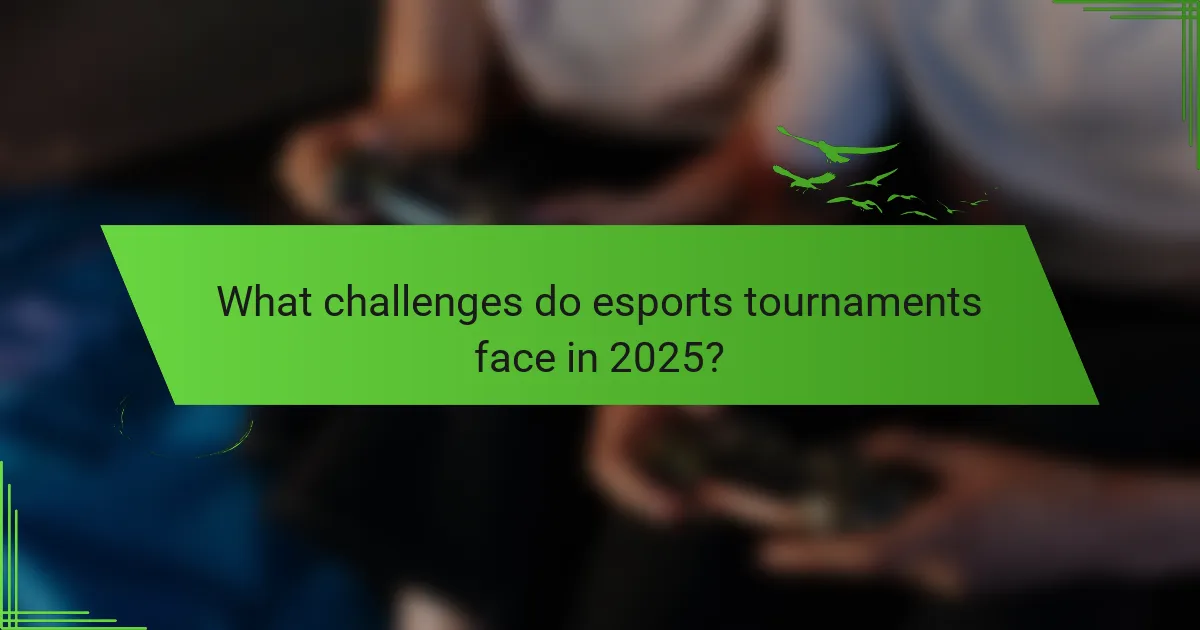
What challenges do esports tournaments face in 2025?
Esports tournaments in 2025 face several significant challenges. Increased competition among platforms leads to fragmented audiences and sponsorship difficulties. Additionally, regulatory scrutiny around player contracts and fair play creates compliance hurdles. Technological issues, such as server reliability and cybersecurity threats, further complicate event execution. Lastly, evolving viewer preferences necessitate constant adaptation in formats and engagement strategies.
How do regulations impact tournament organization?
Regulations significantly shape tournament organization by dictating structure, eligibility, and prize distribution. They ensure fair play, protect players, and maintain integrity in esports. Compliance with local laws and industry standards influences event formats and sponsorship opportunities, impacting overall tournament success. Regulatory frameworks can also affect player contracts and the distribution of earnings, which are critical for establishing trust within the esports community.
What are the common logistical issues in hosting large-scale events?
Common logistical issues in hosting large-scale esports tournaments include venue selection, technology setup, scheduling conflicts, and participant management. These factors can significantly impact the tournament’s success.
Venue selection often involves challenges such as capacity limitations and accessibility. Technology setup requires ensuring reliable internet connections and adequate hardware for all participants. Scheduling conflicts may arise with other events or time zones, complicating coordination. Participant management includes registration processes and communication, which can become overwhelming without proper systems in place.
Addressing these logistical issues is crucial for a smooth tournament experience and can enhance overall engagement and satisfaction.

What trends are shaping the future of esports tournaments?
Esports tournaments are increasingly influenced by trends such as increased viewership, diverse formats, and innovative prize structures. The rise of online streaming platforms has expanded audience reach, while hybrid formats combine in-person and virtual participation. Additionally, prize pools are becoming more lucrative, with some tournaments offering millions in rewards, attracting top talent and sponsors. These factors collectively shape the future landscape of esports tournaments.
How is technology enhancing the tournament experience?
Technology enhances the tournament experience by improving engagement, accessibility, and competition. Advanced streaming platforms allow fans to watch live matches with high-quality visuals and interactive features. Real-time analytics provide players and teams with insights to refine strategies. Virtual reality and augmented reality create immersive environments, enriching the spectator experience. Additionally, online platforms facilitate global participation, allowing players from different regions to compete seamlessly. These innovations elevate the overall excitement and reach of esports tournaments.
What role does community feedback play in tournament evolution?
Community feedback is crucial for the evolution of esports tournaments. It informs organizers about player preferences, game balance, and overall participant experience. This feedback can lead to format adjustments, prize structure changes, and improved engagement. For instance, player input often drives the adoption of new tournament formats, enhancing competitiveness and viewer interest. Additionally, community suggestions can identify unique attributes that attract sponsors and increase prize pools, ultimately benefiting the entire esports ecosystem.
What best practices can organizers adopt for successful tournaments?
Organizers can adopt several best practices for successful esports tournaments. First, establish clear rules and guidelines to ensure fair play. Second, invest in reliable technology to minimize disruptions during matches. Third, promote the tournament effectively to attract participants and audiences. Fourth, provide adequate support for players, including practice facilities and mental health resources. Lastly, gather feedback post-tournament to improve future events.
